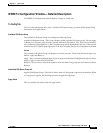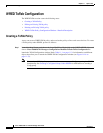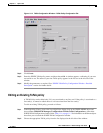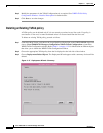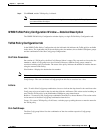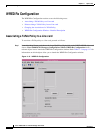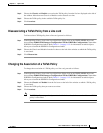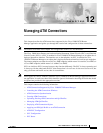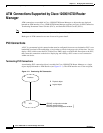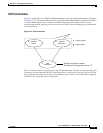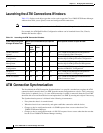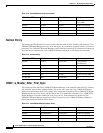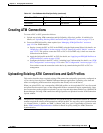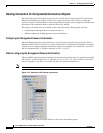
CHAPTER
12-1
Cisco 12000/10700 v3.1.1 Router Manager User Guide
OL-4455-01
12
Managing ATM Connections
This chapter describes the ATM connections supported by the Cisco 12000/10720 Router
Manager application and guides you through the creation and configuration of these connections.
Note The features described in this chapter are not applicable to the Cisco 10720 Routers.
The Cisco 12000 Series Routers use both terminating Permanent Virtual Circuits (PVCs) and Switched
Virtual Circuits (SVCs). A PVC is modeled in Cisco 12000/10720 Router Manager as an object that is
deployed beneath an interface. The interface acts as the endpoint. An SVC is modeled in Cisco
12000/10720 Router Manager as an object that is deployed beneath an interface, but it has two endpoints.
The remote endpoint can either be a non-Cisco EMF endpoint (which means it is outside Cisco EMF) or
a Cisco EMF endpoint (which means it is within Cisco EMF).
SVCs are similar to PVCs in setup; however, they function differently. The PVC is always operating and
is always up. On the other hand, the SVC shuts down when it is not in use. It does not cease to exist, but
only goes down until traffic occurs, then it re-establishes.
Note Fields appear on various windows within the Cisco 12000/10720 Router Manager application that are
not applicable. In such cases these fields should be ignored. Information detailing the fields that should
be ignored are provided in the appropriate sections.
This chapter contains the following information:
• ATM Connections Supported by Cisco 12000/10720 Router Manager
• Launching the ATM Connections Windows
• ATM Connection Synchronization
• Creating ATM Connections
• Uploading Existing ATM Connections and QoS Profiles
• Managing ATM QoS Profiles
• Deploying ATM Connection Objects
• Applying an ATM QoS Profile to an ATM Connection
• ATM PVC Configuration
• SVC Configuration
• PVC Status



